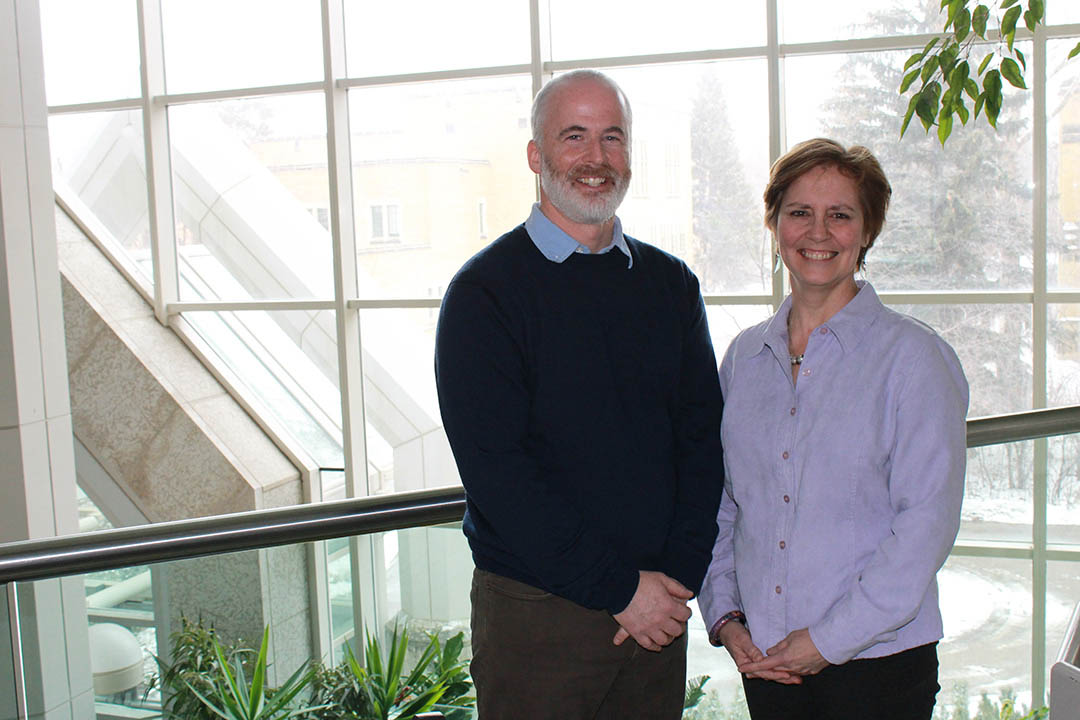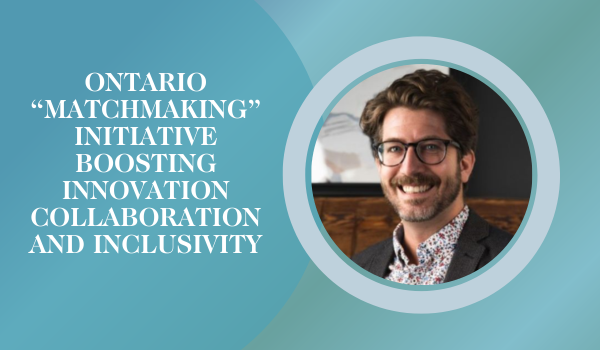NRC president Iain Stewart on the agency’s activities, priorities and future plans
NOTE: This is Part 1 of a two-part Q&A. In Part 2, to be published November 1, NRC president Iain Stewart talks about NRC’s renewal of its facilities and ensuring Canada’s strategic IP and research are protected during collaborations with other countries.
The 107-year-old National Research Council of Canada is the country’s flagship research and innovation agency, with about 4,200 staff, more than 500 students and 118 R&D facilities. The NRC partners with Canadian industry and invests in strategic R&D programming to take research impacts from the lab to the marketplace, where people can experience the benefits.
 Iain S. Stewart’s (photo at right) current term as NRC president started in October 2021. He also served as NRC president from 2016 to 2020. Stewart talked with Mark Lowey, Research Money’s managing editor, about the NRC’s current activities and priorities and plans for the future.
Iain S. Stewart’s (photo at right) current term as NRC president started in October 2021. He also served as NRC president from 2016 to 2020. Stewart talked with Mark Lowey, Research Money’s managing editor, about the NRC’s current activities and priorities and plans for the future.
R$: The federal government for its next budget intends to reduce spending by $15 billion. Will this affect the NRC and how do you plan to manage this reduced spending?
IS: That’s a whole-of-government exercise. We, like all other federal departments and agencies, were given our [expenditure] reductions and had the same targets that everybody had. The basic structure of the reductions were less funding for consulting and travel, and a reduction for operating funding and a reduction for grants and contributions funding. We had to put together a plan, which we put in to our minister, for how we would take onboard those expenditure reductions. The minister in turn on behalf of his portfolio put that into Treasury Board Secretariat for them to review and approve. This process is underway.
Obviously by its very nature, it means that we have less operating resources and less grants and contributions. Of course, the grants and contributions are not money for us. They’re money for clients and collaborators we work with. If you think about the Industrial Research Assistance Program, that means we will have to reduce the number and/or the size of projects we’re working on. In the case of operating funding, we’re going to have to find efficiencies and we’re going to have to look at ways to absorb some of the impact of [the reduced government funding].
The National Research Council, however, is a revenue-dependent organization. We do earn about $180 million to $200 million a year of external revenues for goods and services we provide for research and innovation. So we do have the opportunity – which not every federal entity has – to also look at earning more money to offset the impact of a reduction in our appropriation from the government.
R$: Ottawa intends to transition the NRC’s Industrial Research Assistance Program to the new Canada Innovation Corporation. Has this transition process started yet, what impact will the move have on the NRC including its budget, and will the NRC be initiating any new programs in the area of industrial research assistance?
IS: With respect to new programming, we’re always evolving programming. That’s true for the Industrial Research Assistance Program (IRAP), that’s true for the National Research Council, and we’re not going to stop. Whether it’s IRAP improving its services, whether it’s NRC, we’re not going to stop. The establishment of the Canada Innovation Corporation (CIC) was set out in the government’s blueprint document describing the vision for the CIC. That document said 24 months [to transition IRAP to the CIC], which takes us to February 2025. Over the life of that period, if IRAP sees an opportunity or an innovation, they’re going to pursue it. We’re not standing still.
If you look in the public accounts, you will see the operating funding for IRAP, which is about $105 million. The grants and contributions is about $440 million this most recent fiscal year, if you count core IRAP and some of the programs we deliver for other partners like the Youth Employment Strategy. That [funding] is a lift and shift. Those line items will come out of the NRC budget and they will go into the CIC’s budget. The legislation that created the CIC sets out the funding profile for the new organization and IRAP’s money is in those totals.
There will be other adjustments that we’ll have to make. If you have synergies or economies of scale, the National Research Council is about 4,200 staff and about 540 students. And IRAP is about 500 of those people. So we’re losing a sizeable part of our team who are going to move to this new entity. There will be overhead impacts and so on that we’ll have to work our way through. The actual core money loss is the $105 million and the $440 million, and that will go to CIC.
As for where we’re at in the transfer process, there is a core team at the Canada Innovation Corporation and they are beginning to prepare the organization for core management business processes like payroll, financial systems, those kinds of things. The government is running a process to select the chair [of CIC’s board of directors], which is a ministerial appointment. And I believe with the chair they will run the process for the CEO of CIC. Once there’s a chair and a CEO, they’ll start filling out the C-suite with the level-one vice-presidents and the team will start to come together. For them to operate in a way that they’re able to receive IRAP, they’ll need to have their chair, board and CEO, their management team, and their basic core operating facility so they can pay staff. They’re making good progress on all of those areas. I think you could expect in the beginning of the next fiscal year we’re going to see that infrastructure in place.
For IRAP to then go to CIC, they have to be ready that they can take over legal representation, they can be the employer, they can issue a cheque and so on. There’s some back-office kind of machinery that has to be done. I think we’re all on track and doing fine. For February 2025, things are clicking in place. We have the time to do it and people are well-organized. We set up a dedicated vice-president team in-house and built a network around what are the issues for IT, for human resources, for real property – you name it. And we’re figuring out for each of those areas what’s the way that’s going to be helpful for CIC.
In terms of impacts, for the National Research Council that stays, it’s an experience the organization has had historically a few times. The Atomic Energy Corporation, Natural Sciences and Engineering Research Council, Canadian Health Research Institutes, the Canadian Space Agency, the Communications and Security Establishment, Defence Research and Development Canada – all of these are spinouts from the National Research Council. So in this case, as in the past, we have a program area that has grown to a certain scale, it has a critical mass, it’s got a national presence – everybody knows IRAP – it’s ready to go. It’s a good time for IRAP to move out, to get additional resources through the CIC and to have greater flexibilities by being a Crown corporation. I think it’s going to work well for IRAP. I think we’re going to be able to have more impact and add more value for SMEs.
For the [NRC] labs that watch IRAP go, we become much more optimized. We are now more of a pure play focused on the provision of public sector labs doing collaborative research with university and industrial partners. We have large-scale facilities, technical teams who are dedicated, and we have expert researchers working with those facilities and our clients. So we should be the best public lab that we can possibly be. We should have total focus on achieving a safe, secure, environmentally responsible, high-performing national network of labs. We’re still quite diverse on the topics we work on: astronomy, ocean engineering, life sciences, aerospace, automotive – they’re very different. Each has its own client stakeholders. But the backbone of providing large-scale public [R&D] facilities for the nation – that remains our core focus now. So I think there’s a real optimization opportunity there.
R$: With IRAP being transferred to CIC, will CIC’s clients still have access to NRC labs?
IS: CIC’s clients of course will have access to our labs. When people want to use government labs, IRAP has ways to support people to use government labs. But we don’t steer people to NRC labs. IRAP is always about the client. If the best solution for a client is a community college, that’s where the IRAP industrial technology advisor will tell them to go. We’re focused on the success of the company. IRAP is not a business development tool for the government labs. Where the NRC labs provide a solution, then that business will show up there.
R$: Canada invests significantly in innovation programs and initiatives. Yet this country’s productivity growth continues to lag other OECD countries, with the OECD recently predicting Canada will have the worst-performing advanced economy over 2020-2030. What needs to be done to address this long-standing economic issue and what’s the NRC’s role in doing so?
IS: This is a much-discussed topic. I think anybody in this space could recite it in their sleep. My favourite distillation of the subject is Peter Nicholson’s framing. He said Canadian companies’ propensity to compete on the basis of innovation is lower than you would expect. That lack of competing on the basis on innovation means companies are not using innovation as their competitive advantage. And that drives all of the statistics that we all know so well. We have low business expenditures in R&D. We have low expenditures on machinery and equipment, which is how you buy other people’s innovations. We have low investment in intangibles. We have low use of advanced university degrees. When we do use people with advanced degrees, we pay them less than our competitor countries.
All of that you can wrap back up to: Canadian companies tend to compete not on the basis of innovation. It reflects where [Canada] sits in the North American value chains, the way that the Canadian economy is structured, the important role that the resource economy plays in our GDP. We’re blessed with these massive resources, so there’s lots of ways to make economic activity in Canada occur. And adding innovation into that is not always the choice that Canadian companies make. You have to bear in mind that Canadian companies are very profitable. It’s not like they’re making a mistake that’s hurting them. It may be hurting us overall in our long-term productivity and competitiveness. But you can understand why the status quo hangs in there.
Peter Nicholson has talked in the past how we need some kind of shocks to shock people out of this low-innovation equilibrium. Others have also done extensive diagnostics of this. Dan Breznitz’s book, Innovation in Real Places, I thought was a great insight into how do we do innovation in Canada. I think our ability to get to talking about solutions is in part influenced by the structure of the diagnostic. We have a small business innovation community for the size of our economy. We have a very large public sector research and innovation community, and so the people who exist are the ones who have voices and give voice to the topic and talk about it. In Canada, the discourse tends to be very university-dominated. And the voice of the private sector is smaller. We have the Council of Canadian Innovators. We do have leaders who speak, individual entrepreneurs who speak about the importance of innovation. We have different industry associations who come at the topic. But we don’t have the massive large-scale industrial complex competing through innovation products that you’ll see in a number of the other G7 countries that we compare ourselves with. So our conversation is very not business driven.
Within that context, the role of IRAP is being there working with companies on their terms, making sure they’re ready, and then providing advice and financial support to help them succeed with their innovation projects. IRAP is a well-known, well-understood, well-used program nationally, and it’s having an impact and it works. On the lab side, NRC’s role is to be a service provider. We provide goods and services. Partly we do exploratory research – priming our own pump in the longer term. Partly we do government mandates. You saw that during the COVID-19 pandemic when the government asked us to build a vaccine-manufacturing facility which we did and then spun it out as a not-for-profit.
But the core long-term role of the NRC’s lab system is supporting economic development and business innovation. And there we work with hundreds of companies a year, where we provide testing services or research collaborations or research services to them for their competitive position. Some people say that these technical services are not as important as research services, and there’s a lot of discussion within the NRC about what is the right balance between providing technical services and providing research. But our job is economic impact ultimately. If a jet engine manufacturer develops a new jet engine and they need to have that certified to be able to sell it in Europe, we’ll do that certification campaign for them. It’s a technical service. If we don’t do it, that product can’t get sold. That’s an innovation that won’t reach market. So basic research assistance, research in goods and services and products, and technical services are the total offering that we provide through the National Research Council.
Other countries recognize the role that these kinds of public-oriented labs play, much more than in Canada. In Canada, people tend to think if you provide financial assistance the companies will kind of work it out. But in reality, for very advanced research and technology-oriented businesses, they often need technical advice and help and they need access to facilities. We have excellent universities that provide a lot of technical advice and the professors and their labs and facilities are very useful. Our community college network, through the Technology Access Centres, do a lot of very on-the-ground work helping companies figure out their next technological jump. And the NRC’s labs, which provide large-scale dedicated teams, are able to handle sustained, sophisticated [R&D] campaigns with companies. So all of these pieces play an important role. I feel in Canada, we undervalue that ability to provide advice and technical facilities to companies on their terms for their business products. I think we need to talk more about that as a country.
R$: If we’re not having, as you pointed out, a business-engaged conversation about weak productivity, and that business isn’t involved very much in the diagnosis of this problem, maybe we need to change the conversation?
IS: It is partly the motivation for the reason why government wanted to create the new Canada Innovation Corporation. They wanted to have an entity solely focused on business innovation, with the federal family. The blueprint document sets out that the CIC is meant to pursue whole kinds of program activity. Specifically, it’s meant to provide diagnostics and solutions for our realities here in Canada. So it’s meant to become a bit of an epi-centre for thinking about what does the business innovation community need in Canada and how can we provide it as a community. I think that’s going to be a very beneficial addition to our community.
R$: Attracting and retaining talent is an ongoing priority for Canada’s innovation ecosystem, especially given the global competition for talent. What is the NRC doing on this front?
IS: The National Research Council lab network uses talent, we’re a consumer of talent. We try to bring talent into our activity, so people have the access to our facilities and our projects. When I started at NRC we had about 120 students a year. Now we’re up to about 540 a year. Just having more students on our campuses and involved in our projects is a good thing. In 2017, we created a post-doc program. It’s boutique program, it’s not very big. But we set up the post-doc program to try and add really exciting opportunities to the market for people coming out of their PhD program to give them exposure to working in an applied, teamed environment like we do here. We of course hire post-docs anyway, just through our operating funding. But we’ve tried to create a bit of a program that was meant to offer really interesting research opportunities. It has been a good success, it has strong take-up. Staff at the NRC are adjunct professors so they’re able to be part of universities, and they can have students and supervise students. Many of our research officers are adjuncts, do have students, and that’s part of how they do what they do. We do a lot of collaboration with universities. We’ve gone out of our way to create vehicles to collaborate. So we mix it up: student body with the post-docs and with faculty.
On the IRAP side of the discussion, hiring people is actually what IRAP is predominantly about. If you look at the average IRAP project, it’s providing the financial assistance for labour costs. Quite often, if you talk to entrepreneurs who’ve benefitted from IRAP, they go out of their way to talk about how IRAP helped them hire their first student and their second student. And that was the beginning of what these companies became. So there’s a lot of affection for the contribution of talent early into the new company. We have a relationship with Employment and Social Development Canada’s program and the Youth Employment Skills Strategy. We do hundreds [of collaborations] a year. This is very beneficial. Just like Mitacs does, you’re trying to make sure the university talent is finding its feet into the private sector. We’re weak in the Canadian system on the use of advanced research degrees. So making sure that the talent we do produce finds local opportunities is just so vital. Mitacs is huge in that. And through IRAP, we’re huge in funding companies in effect to build up their labour pool as part of their growth from being a startup to an SME.
R$
Events For Leaders in
Science, Tech, Innovation, and Policy
Discuss and learn from those in the know at our virtual and in-person events.
See Upcoming Events
You have 0 free articles remaining.
Don't miss out - start your free trial today.
Start your FREE trial Already a member? Log in
By using this website, you agree to our use of cookies. We use cookies to provide you with a great experience and to help our website run effectively in accordance with our Privacy Policy and Terms of Service.





